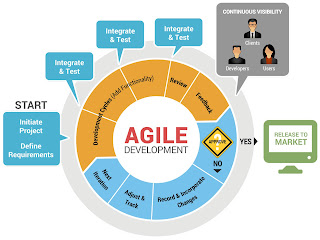What is Agile Testing?
Agile testing is dynamic approach for testing. In this testing requirement does not stable mean to say it keeps change according to customer so in this situation we need to use dynamic approach for testing and this approach called Agile testing. These days almost companies are using agile testing.
Need of Agile?
In waterfall and V models, it is no easy to manage the frequent changing in functionality and requirements. To short out this issue Agile mythology came into the picture. Agile methodology provides a process through which, we can manage the requirement changes easy.
Agile testing is used whenever customer requirements are changing dynamically, or the high level documents, related to requirements are not available.
Features of Agile methods:
1. Iterative development – Tested features developed in order of business priority.
2. Responsive to changing requirement – Many opportunities to re priorities and re-evaluate.
3. Product owner (client) is the part of the team.
4. Focus on delivering business values.
5. Test driven.
6. The team review and improve their own processes regularly
Agile Principles:
1. Satisfy the customer through early and continuous delivery of valuable software.
2. Working software is the primary measure of progress.
3. Deliver working software frequently, from a couple of weeks to a couple of months.
4. Welcome changing requirements, even late in development.
5. The most efficient and effective method of conveying information to and within a development team is face-to-face conversation.
6. Business people and developers must work together daily throughout the project.
7. Simplicity--the art of maximizing the amount of work not done--is essential.
Role of tea, members in Agile method:
1. Customer (Product Owner): The person responsible for defining Requirements (Product Backlog items) and prioritising items for each Iteration / Sprint.
2. Coach (scrum Master): The person whose primary role is to remove impediments blocking the team.
3. Team of Developer and Tester: Collaborating to produce running, tested features.
Refer to the like for more detail - http://www.scrum-institute.org/What_Is_Scrum.php
Agile Development Methodology:
Agile is a iterative development methodology, where requirements evolve through collaboration between customer and self organization team Agile business approach aligns development with customer needs.
Agile Testing process:
Value of testing in agile development
1. Testing in agile software development should provide the information that stakeholders need to make decisions and steer the development into the right direction
2. This information must be provided promptly
3. Testing provides data on the status of the deliverables and generates project intelligence
4. Project intelligence is knowledge of risks and benefits
5. Knowledge of risks, benefits, test records and results are more valuable than test documentation and infrastructure
Tester – Developer cooperation:
Waterfall Model:
1. Different team.
2. Mostly communication only by management tools.
3. Different aims
4. Not involve in requirement analysis and planning.
5. Time delay between coding and testing.
Agile Model:
1. One project team.
2. Close communication with team.
3. The same aim.
4. Together analyze requirement and plan.
5. Parallel with developer.
Agile testing is dynamic approach for testing. In this testing requirement does not stable mean to say it keeps change according to customer so in this situation we need to use dynamic approach for testing and this approach called Agile testing. These days almost companies are using agile testing.
Need of Agile?
In waterfall and V models, it is no easy to manage the frequent changing in functionality and requirements. To short out this issue Agile mythology came into the picture. Agile methodology provides a process through which, we can manage the requirement changes easy.
Agile testing is used whenever customer requirements are changing dynamically, or the high level documents, related to requirements are not available.
Features of Agile methods:
1. Iterative development – Tested features developed in order of business priority.
2. Responsive to changing requirement – Many opportunities to re priorities and re-evaluate.
3. Product owner (client) is the part of the team.
4. Focus on delivering business values.
5. Test driven.
6. The team review and improve their own processes regularly
Agile Principles:
1. Satisfy the customer through early and continuous delivery of valuable software.
2. Working software is the primary measure of progress.
3. Deliver working software frequently, from a couple of weeks to a couple of months.
4. Welcome changing requirements, even late in development.
5. The most efficient and effective method of conveying information to and within a development team is face-to-face conversation.
6. Business people and developers must work together daily throughout the project.
7. Simplicity--the art of maximizing the amount of work not done--is essential.
Role of tea, members in Agile method:
1. Customer (Product Owner): The person responsible for defining Requirements (Product Backlog items) and prioritising items for each Iteration / Sprint.
2. Coach (scrum Master): The person whose primary role is to remove impediments blocking the team.
3. Team of Developer and Tester: Collaborating to produce running, tested features.
Refer to the like for more detail - http://www.scrum-institute.org/What_Is_Scrum.php
Agile Development Methodology:
Agile is a iterative development methodology, where requirements evolve through collaboration between customer and self organization team Agile business approach aligns development with customer needs.
Agile Testing process:
Value of testing in agile development
1. Testing in agile software development should provide the information that stakeholders need to make decisions and steer the development into the right direction
2. This information must be provided promptly
3. Testing provides data on the status of the deliverables and generates project intelligence
4. Project intelligence is knowledge of risks and benefits
5. Knowledge of risks, benefits, test records and results are more valuable than test documentation and infrastructure
Tester – Developer cooperation:
Waterfall Model:
1. Different team.
2. Mostly communication only by management tools.
3. Different aims
4. Not involve in requirement analysis and planning.
5. Time delay between coding and testing.
Agile Model:
1. One project team.
2. Close communication with team.
3. The same aim.
4. Together analyze requirement and plan.
5. Parallel with developer.






No comments:
Post a Comment